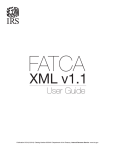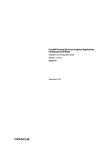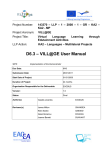Download Oracle Financial Services FATCA Management Configuration Guide
Transcript
Oracle Financial Services
FATCA Management
Configuration Guide
Release 1.0
January 2013
Oracle Financial Services
FATCA Management
Configuration Guide
Release 1.0
January 2013
Document Control Number: 9RVE1181001-0003
Document Number: CG-12-FT-OOO3-1.0-01
Oracle Financial Services Software, Inc.
1900 Oracle Way
Reston, VA 20190
Document Number: CG-12-FT-OOO3-1.0-01
First Edition (January 2013)
Copyright © 1996-2013, Oracle and/or its affiliates. All rights reserved.
Printed in U.S.A. No part of this publication may be reproduced, stored in a retrieval system, or transmitted in any form or by
any means, electronic, mechanical, photocopying, recording, or otherwise without the prior written permission.
Trademarks
Oracle is a registered trademark of Oracle Corporation and/or its affiliates.
Other names may be trademarks of their respective owners.
Oracle Financial Services Software Ltd.
1900 Oracle Way
Reston, VA 20190
Phone: (703)-478-9000
Fax: (703)-318-6340
Internet: www.oracle.com/financialservices
Contents
List of Figures .................................................................................................................. v
List of Tables .................................................................................................................. vii
About this Guide ............................................................................................................. ix
Who Should Use this Guide ...............................................................................................................................................ix
Scope of this Guide...............................................................................................................................................................x
How this Guide is Organized ..............................................................................................................................................x
Where to Find More Information .....................................................................................................................................xi
Conventions Used in this Guide ........................................................................................................................................xi
C HAPTER 1
OFS FATCA Management User Setup............................................ 1
Creating Users ........................................................................................................................................................................1
Mapping Users to User Group............................................................................................................................................2
C HAPTER 2
Creating Jurisdiction and Data for IRS Published FFIs in
Database........................................................................................... 3
Creating Jurisdiction in the Database .................................................................................................................................3
Entering FATCA IDs for Customers in Database...........................................................................................................4
C HAPTER 3
Configuring FATCA Status Parameters ......................................... 5
Configuring Account Opening Cut-off Date....................................................................................................................6
Configuring Attribute Values for FATCA Account Classes ...........................................................................................6
Managing FATCA Customer Status ...................................................................................................................................7
C HAPTER 4
Batch Execution in FATCA Management....................................... 9
Oracle Financial Services FATCA Management 1.0 Configuration Guide
iii
Contents
iv
Oracle Financial Services FATCA Management 1.0 Configuration Guide
List of Figures
Figure 1. Configuring Common Attributes ....................................................................... 6
Figure 2. Customer Status Administration Screen............................................................ 8
Oracle Financial Services FATCA Management 1.0 Configuration Guide
v
List of Figures
vi
Oracle Financial Services FATCA Management 1.0 Configuration Guide
List of Tables
Table 1.
Table 2.
Table 3.
Table 4.
Table 5.
Conventions Used in this Guide ........................................................................ xi
User Group Code and Properties....................................................................... 1
KDD_JRSDCN Table Attributes....................................................................... 3
DIM_IRS_FFI_LT Table Attributes.................................................................. 4
FATCA Account Class and Configurable Attributes....................................... 7
Oracle Financial Services FATCA Management 1.0 Configuration Guide
vii
List of Tables
viii
Oracle Financial Services FATCA Management 1.0 Configuration Guide
About this Guide
This guide explains the structure behind the Oracle Financial Services Foreign
Account Tax Compliance Act (OFS FATCA) Management application and provides
comprehensive instructions for configuring modifiable components.
This chapter focuses on the following topics:
Who Should Use this Guide
Scope of this Guide
How this Guide is Organized
Where to Find More Information
Conventions Used in this Guide
Who Should Use this Guide
The Oracle Financial Services Foreign Account Tax Compliance Act Management Configuration
Guide is designed for use by Oracle Financial Services Installer and System
Administrators. These users should have functional knowledge of OFS FATCA
Management application and UI software components. Their roles and
responsibilities, as they operate within the Oracle Financial Services Foreign Account Tax
Compliance Act Management application, include the following:
Oracle Financial Services Installer: This user installs and configures the
Oracle Financial Services Applications and the client-specific solution sets at a
deployment site. This user also installs, upgrades, and additional solution sets. It
requires access to deployment-specific configuration information (for example,
machine names and port numbers).
System Administrator: This user configures, maintains, and adjusts the
system and is usually an employee of a specific Oracle Financial Services client.
The System Administrator maintains user accounts and roles, archives data, and
loads data feeds.
Oracle Financial Services FATCA Management 1.0 Configuration Guide
ix
Scope of this Guide
About this Guide
Scope of this Guide
This guide provides detailed instructions for configuring the Oracle Financial Services
Foreign Account Tax Compliance Act Management application for all configurable
features as defined in. Configuring the application requires an understanding of, and
ability to work with, databases. Configurable parameters are maintained in a Database
table, which can be configured by executing simple update statements detailed in this
guide. The Behavior Detection Platform provides the foundation for Oracle Financial
Services solution sets. It provides an open and scalable infrastructure that supports
rich, end-to-end functionality across all Oracle Financial Services behavior detection
solution sets as well as Oracle Financial Services Foreign Account Tax Compliance
Act Management application. This guide contains instructions on how to configure
components of the system.
Note: Oracle Financial Services Software, Inc. supports the configurable items that
this guide describes. It does not support any customizations made outside these
items and cannot be held responsible for the outcome of such changes.
How this Guide is Organized
The Oracle Financial Services Foreign Account Tax Compliance Act Management Configuration
Guide, includes the following topics:
x
Chapter 1, OFS FATCA Management User Setup, describes how to create FATCA
users and map them to the appropriate user role.
Chapter 2, Creating Jurisdiction and Data for IRS Published FFIs in Database,
describes how to create jurisdiction in the database and also how to create data
for IRS published FFI in the database.
Chapter 3, Configuring FATCA Status Parameters, describes how to configure the
FATCA status parameters.
Chapter 4, Batch Execution in FATCA Management, describes about batch
execution in FATCA.
Oracle Financial Services FATCA Management 1.0 Configuration Guide
Where to Find More Information
About this Guide
Where to Find More Information
For more information about the Oracle Financial Services Foreign Account Tax
Compliance Act Management application, refer to the following documents:
Oracle Financial Services Behavior Detection Platform Administration Guide
Oracle Financial Services Behavior Detection Platform Installation Guide - Stage 1
Oracle Financial Services Foreign Account Tax Compliance Act Management Installation
Guide - Stage 3
Oracle Financial Services Foreign Account Tax Compliance Act Management User Guide
To find additional information about how Oracle Financial Services solves real
business problems, see our website www.oracle.com/financial services.
Conventions Used in this Guide
Table 1 lists the conventions used in this guide.
Table 1. Conventions Used in this Guide
Convention
Italics
Meaning
Names of books, chapters, and sections as references
Emphasis
Bold
Object of an action (menu names, field names, options,
button names) in a step-by-step procedure
Commands typed at a prompt
User input
Monospace
Directories and subdirectories
File names and extensions
Process names
Code sample, including keywords and variables within
text and as separate paragraphs, and user-defined
program elements within text
<Variable>
Substitute input value
Oracle Financial Services FATCA Management 1.0 Configuration Guide
xi
Conventions Used in this Guide
About this Guide
xii
Oracle Financial Services FATCA Management 1.0 Configuration Guide
CHAPTER 1
OFS FATCA Management User
Setup
There are some predefined user roles for accessing OFS FATCA application. This
chapter discusses about the steps to provide access to the users in the application.
This chapter includes the following topics:
Creating Users
Managing User Group and User Roles
Creating Users
This section explains how to create users and provide access to OFS FATCA
Management application. OFS FATCA application has pre-defined user roles for
accessing the application.
To set up a user and provide the user access to OFS FATCA application, follow these
steps:
1. For creating users, refer to Oracle Financial Services Analytical Applications
Infrastructure User Manual Release 7.3.
2. Once the users are created, map the users to the pre-defined user groups, which
in turn map to a user role.
Note: For more information about the above sections, refer to Oracle Financial
Services Analytical Applications Infrastructure User Manual Release 7.3.
The following table describes the pre-defined user groups and their roles:
Table 2. User Group Code and Properties
User Role
User Group Code
User Group Properties
Users mapped to the FATCA ADMN group
can perform the following actions:
Execute FATCA Batches.
Use the Account Status menu to edit
Administrator User
FATCAADMN
attributes associated with a FATCA
account class and other common
attributes.
Use the Customer Status menu to set
the priority of FATCA statuses for the
Individual and Entity customer types.
Oracle Financial Services FATCA Management 1.0 Configuration Guide
1
Mapping Users to User Group
Chapter 1—OFS FATCA Management User Setup
Table 2. User Group Code and Properties
User Role
User Group Code
User Group Properties
Analyst User
FATCAANYST
Uers mapped to the FATCAANYST group
can use the FATCA Accounts menu to
search FATCA assessments.
Mapping Users to User Group
This section discusses about mapping the users to the user group.
If the users need to have FATCA Admin role then user should be mapped to a
FATCA Administrator user group.
If the users need to have FATCA Analyst role then users should be mapped to
FATCA Analyst user group.
For more information about User to User Group mapping, refer to Oracle Financial
Services Analytical Applications Infrastructure User Manual Release 7.3.
2
Oracle Financial Services FATCA Management 1.0 Configuration Guide
CHAPTER 2
Creating Jurisdiction and Data for IRS
Published FFIs in Database
Internal Revenue Service (IRS) has a list of participating Foreign Financial Institutions
(FFI) who are regarded as registered deemed-compliant FFIs having a valid
withholding certificate establishing the payee's foreign status. The FFI list will also
include the Foreign Financial Institution Employer Identification Number (FFI EIN),
which are used to identify an entity. Each FFI member will be assigned a unique
Foreign Account Tax Compliance Act Identifier (FATCA ID) to be used in
completing the registration process and associating FFI group members with the FFI
group.
Records from the Oracle Financial Services client that the Ingestion Manager loads
must be identified with a jurisdiction. Users of the system must be associated with one
or more jurisdictions. You can use a jurisdiction to divide data in the database. For
example, the division of data based on geographical boundaries, such as countries are
classified under geographical jurisdiction.
This chapter includes the following topics:
Creating Jurisdiction in the Database
Entering FATCA IDs for Customers in Database
Creating Jurisdiction in the Database
This section explains how to create jurisdiction in the Database.
To create a jurisdiction in the database, follow these steps:
1. Add the appropriate record to the KDD_JRSDCN database table under Alert
Management Schema. The following table describes the attributes.
Table 3. KDD_JRSDCN Table Attributes
Column Name
Description
JRSDCN_CD
A code (one to four characters) that represents a jurisdiction (for
example, N for North, or S for South).
JRSDCN_NM
Name of the jurisdiction (for example, US).
JRSDCN_DSPLY_NM
Displays name of the jurisdiction (for example, DN of United
States).
JRSDCN_DESC_TX
Description of the jurisdiction (for example, Northern US or
Southern US).
2. Add records to the table by using a SQL script.
Oracle Financial Services FATCA Management 1.0 Configuration Guide
3
Entering FATCA IDs for Customers in Database
Chapter 2—Creating Jurisdiction Data and IRS Published FFI List
For example,
insert into kdd_jrsdcn (jrsdcn_cd, jrsdcn_nm, jrsdcn_dsply_nm,
jrsdcn_desc_tx) values('US','US','DN of United States','United
States');
commit;
Note: This jurisdiction code should match with the SRC_JURISDICTION_CODE
value provided under GRC_InstallConfig.xml at the time of installation.
Entering FATCA IDs for Customers in Database
This section explains how to enter data for IRS Published FFIs in Database.
To enter data for IRS published FFIs in the database, follow these steps:
1. Add the appropriate record to the DIM_IRS_FFI_LT FATCA Atomic Schema.
Refer below table for description.
Table 4. DIM_IRS_FFI_LT Table Attributes
Column Name
Description
CUST_INTRL_ID
Customer ID of account holders who are present in the IRS
published list of FFIs. This Should match with Cust_Intrl_Id
in Customer table of Business Schema.
FATCA_INTRL_ID
Associated FATCA ID for the customer provided by IRS in the
list.
2. Add records to the table by using a SQL script.
For example,
insert into dim_irs_ffi_lt(cust_intrl_id,fatca_intrl_id) values
('FATCUNPFI-097','1001');
commit;
4
Oracle Financial Services FATCA Management 1.0 Configuration Guide
CHAPTER 3
Configuring FATCA Status
Parameters
The FATCA status of customers will be derived from the FATCA status of the
account(s) held by them. If the customers are associated to only one account, or if all
their accounts have the same FATCA status, then the customers will have the same
FATCA status as the account(s).
If the customers are associated to more than one account which do not have the same
FATCA status, then amongst all such statuses, the one with the highest priority will be
assigned to the customers.
This chapter includes the following topics:
Configuring Account Opening Cut-off Date
Configuring Attribute Values for FATCA Account Classes
Managing FATCA Customer Status
Oracle Financial Services FATCA Management 1.0 Configuration Guide
5
Configuring Account Opening Cut-off Date
Chapter 3—Configuring FATCA Status Parameters
Configuring Account Opening Cut-off Date
The account opening cut-off date is defined by IRS. The Account Opening Cut-off
Date attribute is a common parameter based on the value of the country field. This
section explains how configure the cut-off date.
Figure 1. Configuring Common Attributes
To configure the account opening cut-off date, follow these steps:
1. In the Administration menu, select Account Status.
2. Select the country name from the Country drop-down list.
3. Select the Account Opening Cut-off Date using the calendar icon and click
Save. The following message displays: This change has been successfully saved.
4. Click OK. The Account Opening Date is updated successfully.
Configuring Attribute Values for FATCA Account Classes
This section describes how to configure the different attributes for FATCA account
classes. These attributes are used by FATCA rules for identifying the FATCA status of
accounts. Different attributes are associated with each account class. Some attributes
are configurable.
To configure account class-specific attributes, follow these steps:
1. In the Administration menu, select Account Status.
2. Select the country name from the Country drop-down list.
6
Oracle Financial Services FATCA Management 1.0 Configuration Guide
Managing FATCA Customer Status
Chapter 3—Configuring FATCA Status Parameters
3. Select the FATCA Account Class for the attribute you want to update from the
Account Class drop-down list. The attributes associated with the selected
FATCA Account Class display.
The following table describes the account classes and their configurable
parameters.
Table 5. FATCA Account Class and Configurable Attributes
FATCA Account Class
Configurable Attributes
New Individual - Exempt
FATCA Status, Account Type, Account
Balance.
New Individual - US Resident-Tax
FATCA Status, Account Type, Account
Balance.
New Individual - Non US Resident-Tax
FATCA Status, Account Type, Account
Balance.
New Entity - US
FATCA Status
New passive - NFFE - US
FATCA Status
New passive - NFFE - Non US
FATCA Status
New Active NFFE
FATCA Status
New Participating Financial Institution
FATCA Status
New Non-Participating Financial
Institution
FATCA Status
New Non-Participating Financial
Institution-Exempt
FATCA Status
4. Update the pertinent attribute values and click Save. The following message box
displays: The changes have been successfully saved.
5. Click OK. The selected account class attributes are successfully updated.
Managing FATCA Customer Status
There is default priority for each FATCA status. These priorities are used to determine
the FATCA status of customer.
You can configure the priority of the FATCA status from the Customer Status
Administration screen. There are two set of priorities for customer types, namely
Individual and Entity.
To set the priority of the FATCA status, follow these steps:
1. Select the Customer Status from the Administration menu.
2. Select the Country Name from the Country drop-down list.
3. Select the customer type from the Customer Type drop-down list (for
example, Individual or Entity).
4. The associated FATCA statuses and their priorities display.
Oracle Financial Services FATCA Management 1.0 Configuration Guide
7
Managing FATCA Customer Status
Chapter 3—Configuring FATCA Status Parameters
Figure 2. Customer Status Administration Screen
5. Select the check box for the FATCA status and enter the priority numbers.
6. Click Save to update the priority numbers. The following message displays:
Update Operation Successful.
7. Click OK. The priority numbers are successfully updated for the FATCA
statuses.
8
Oracle Financial Services FATCA Management 1.0 Configuration Guide
CHAPTER 4
Batch Execution in FATCA
Management
There are batches to identify the FATCA status of an account, which are predefined in
the application that runs the FATCA rules.
The following are the two types of batches, which are predefined in the application:
1. <INFODOMNAME>_DI: This batch is to be executed only once during deployment
and the purpose of the batch is based on the account opening cut-off date. After
the installation of OFS FATCA Management application, run this batch to assess
the status of account and the customers based on the account opening cut-off
date.
2. <INFODOMNAME>_CHG_LOG: If there are any changes in the information of
existing assessed accounts and customers then run this batch to update the
FATCA status .
Note: While running <INFODOMNAME>_CHG_LOG batch, the Information Date must
be greater than the last used Information Date for either batches. Otherwise, the
batch execution will not be successful. The frequency of this batch execution
depends on the frequency of change in account and customer information. For
more information on how to run batch execution in OFS FATCA Management
application, refer to Oracle Financial Services Analytical Applications Infrastructure User
Manual Release 7.3.
Oracle Financial Services FATCA Management 1.0 Configuration Guide
9
Chapter 4—Batch Execution in FATCA
10
Oracle Financial Services FATCA Management 1.0 Configuration Guide










































